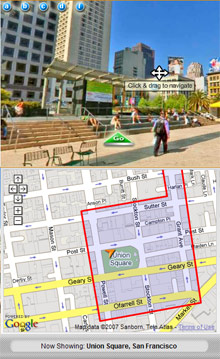A New Perspective on the Virtual World
Everyscape, a startup based in Waltham, MA, is getting in on the rush to create a virtual version of the real world. Although the site will launch this fall under the shadow of mapping giant Google Earth, Everyscape’s cofounders say that users will find the company’s look and feel quite different. “We’re working on a human experience,” CEO Jim Schoonmaker says. “Google has built a superhuman experience.”

Everyscape’s demo opens in the middle of San Francisco’s Union Square, below the Dewey Monument. Users can choose the auto-drive mode, which gives a virtual tour of the area’s sights and shops, or they can explore on their own. Auto drive orients a user by showing her the general layout of Union Square before taking her into Harry Dentin’s Starlight Lounge and bringing her out again for a dizzy, swirling look at the night sky above the Dewey Monument.
The site is designed to give a full immersive experience. A user should be able to tour Union Square virtually, Schoonmaker says, and then feel comfortable navigating it in real life.
Google Earth, in contrast, opens with a satellite’s view of the earth resting in space. From there, users can fly down to explore chosen terrain or look out at the stars. While many areas are created with flat satellite photos, some locations include links to street-level photos taken by users. Images showing a 3-D view of certain buildings can also be layered onto the map, using a special programming language called KML.
Multimedia
See an animation of MIT’s Infinite Corridor, built using the technology behind Everyscape.
In Everyscape, building interiors are constructed the same way as the rest of the environment: by stitching together a series of panoramic photographs taken by company photographers or contributed by users. Within each photograph, a user can swivel through a full sphere of motion. To move users from within one panoramic photograph to the next, Everyscape’s servers estimate the locations of the cameras in each photograph and use that information to build sparse 3-D geometry that forms the building blocks for an animated 3-D transition. Everyscape CTO and founder Mok Oh says that the transition works because it simulates people’s real-life attitude toward moving from place to place. “Getting there is not what you want,” he says. “Being there is what you want.”
Derek Hoiem, a researcher at the University of Illinois at Urbana-Champaign who designed the technology behind the 3-D site Fotowoosh, says that 3-D immersive sites are popular now because of their appeal to users. “When you’re able to control the environment, it feels more lifelike,” he notes. While Hoiem says that Everyscape’s technology gives a good approximation of motion, he also says that he would like to see greater freedom of movement, rather than just swiveling and transitioning.
Ironically, the original version of Everyscape’s technology, used by the first company that Oh founded, Mok3, had the type of capability that’s on Hoiem’s wish list. Mok3 built software that can use panoramic photographs to generate environments interactive enough for a game engine, and that looks much like a walk-through captured on video. (See the Infinite Corridor animation.) In search of a business model, Oh scaled back the technology to make it transfer more easily over the Internet and founded SuperTour Travel, which created interactive environments to show off high-end hotels and other travel destinations to potential customers. With Everyscape, Oh hopes to use what he learned with SuperTour to virtually reproduce the entire world.
In a business model based in part on SuperTour’s, Everyscape plans to make money by helping businesses build their interiors for a fee. Schoonmaker says that he expects shopkeepers to understand the need to virtually display their physical inventory and store layout. “That’s where all their money went,” he says. “That’s what they need to show you.” In the future, Schoonmaker hopes to add more interactive features to help businesses function virtually. Future additions might give users the ability to buy merchandise inside a store with the click of a mouse, or might add a virtual maître d’ that could help visitors make dinner reservations at a restaurant and recommend items on the menu.
Everyscape plans to launch this fall with environments for parts of San Francisco, Boston, and New York. Other future plans include adding user-controlled avatars and features for mobile devices.
Keep Reading
Most Popular
Large language models can do jaw-dropping things. But nobody knows exactly why.
And that's a problem. Figuring it out is one of the biggest scientific puzzles of our time and a crucial step towards controlling more powerful future models.
How scientists traced a mysterious covid case back to six toilets
When wastewater surveillance turns into a hunt for a single infected individual, the ethics get tricky.
The problem with plug-in hybrids? Their drivers.
Plug-in hybrids are often sold as a transition to EVs, but new data from Europe shows we’re still underestimating the emissions they produce.
Google DeepMind’s new generative model makes Super Mario–like games from scratch
Genie learns how to control games by watching hours and hours of video. It could help train next-gen robots too.
Stay connected
Get the latest updates from
MIT Technology Review
Discover special offers, top stories, upcoming events, and more.